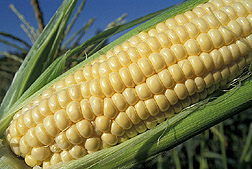This page has been archived and is being provided for reference purposes only. The page is no longer being updated, and therefore, links on the page may be invalid.
Beneficial Fungal Strains Fight Harmful Ones in Corn
By Jim CoreFebruary 22, 2005
Nontoxic strains of a fungus have been developed by the Agricultural Research Service (ARS) to control toxins produced by a different strain of the same fungus in corn.
Aflatoxin is a naturally occurring mycotoxin produced by the fungus Aspergillus parasiticus and the more common A. flavus, which is most often found when certain grains are grown under stressful conditions, such as drought. Aflatoxin occurs in contaminated agricultural commodities, such as corn, peanuts, cotton seed and nuts, and may also be found in soil, decaying vegetation, hay and stored grains during moist and hot conditions.
ARS scientists developed two fungal strains that don't produce these toxins in corn crops. The two nontoxic strains of A. flavus, called CT3 and K49, can be used to competitively displace, or out-compete, the pest strain, according to Hamed K. Abbas, a plant pathologist with the Crop Genetics and Production Research Unit in Stoneville, Miss.
Aflatoxins are a potential danger to food and a significant threat to feed quality. The threat of aflatoxin contamination limits corn production in the Southern United States. Hot, dry conditions are particularly conducive to fungal growth and aflatoxin production. Aflatoxin outbreaks devalue the corn, sometimes making it worthless and costing corn growers hundreds of millions of dollars.
Using the beneficial fungus to treat soil that naturally contains high levels of toxin-producing Aspergillus reduced contamination of corn by 60 to 85 percent. When a nontoxic fungal mixture was mixed with toxin-producing A. flavus and used to treat soil, corn had 65 to 94 percent less aflatoxin, compared to corn grown in soil treated with the toxin-producing fungal strain alone.
ARS has filed a patent application on the nontoxic fungal strains. Abbas developed the strains during four years of field trails with Robert M. Zablotowicz, a soil scientist located in Stoneville.
Further trials are needed to demonstrate that the fungal mixtures are effective under varying conditions naturally found in southern corn production. Additional research will determine the most effective and consistent application methods.
ARS is the U.S. Department of Agriculture's chief scientific research agency.

